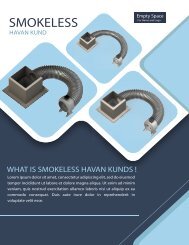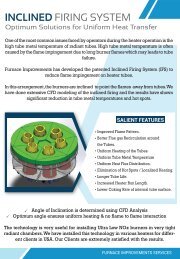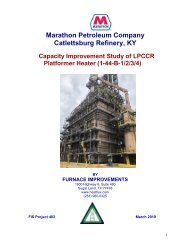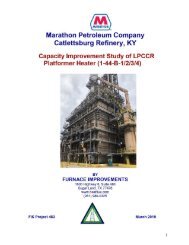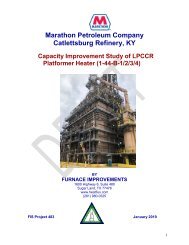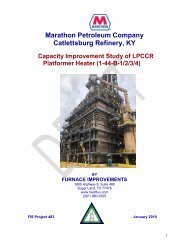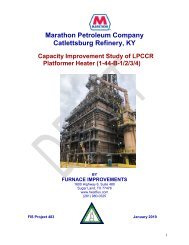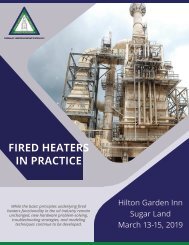FIS-483 Engineering Study Report R1.03.11.19
You also want an ePaper? Increase the reach of your titles
YUMPU automatically turns print PDFs into web optimized ePapers that Google loves.
Marathon Petroleum Company, Catlettsburg Refinery, KY<br />
Capacity Improvement <strong>Study</strong> of LPCCR Platformer Heater (1-44-B-1/2/3/4)<br />
1.3 Operating Observations<br />
<strong>FIS</strong> has analyzed daily operating data of Platformer Heater for one year provided by<br />
Marathon. The following observations were made regarding the current operation of<br />
the heater:<br />
❖ Average feed flow rate to each cell is 263,190 lb/hr.<br />
❖ Average firing rate is 235.22 MMBtu/hr.<br />
❖ Feed inlet and outlet temperature in each cell are lower than the original design<br />
temperatures. Feed temperature rise in Charge Heater, inter heater 1 and Inter<br />
Heater 2 is higher than the design by 20°F.<br />
❖ Flue gas temperature leaving the convection section is around 571°F.<br />
❖ The excess O2 in the flue gas is in the range of 4.4%.<br />
❖ The burners are operated at higher fuel gas pressure in all the radiant cells than<br />
the original design. The average fuel gas pressure for No.1 Interheater, Charge<br />
heater, No.2 Interheater and No.3 Interheater are 22.2 psig, 25.1 psig, 22.4 psig<br />
and 28.5 psig respectively.<br />
❖ Firing rate (LHV) calculated from fuel pressure almost matches the firing rate<br />
provided by client<br />
❖ The calculated bridgewall temperature is higher than the actual. It could be that<br />
the radiant absorbed duty is higher than the calculated. Operating data<br />
simulation is indicating that the firing rates should be lower than the actual. It is<br />
also indicating that actual steam production is lower than calculated. We are not<br />
able to close the heat balance. This could be due to fuel gas flow measurement.<br />
1.4 Recommendation<br />
<strong>FIS</strong> recommends recovering process absorbed heat duty in convection section<br />
based on <strong>FIS</strong> Patented Split Flow Technology. We have optimized the required<br />
process absorbed duty as well as the design steam generation.<br />
In the proposed split flow arrangement, the process flow to the heater is split<br />
between radiant and convection sections. About 22.4-26.5% of the charge rate<br />
goes to the convection section split flow coil and the balance to the radiant coils.<br />
<strong>FIS</strong> proposes to run split flow piping from the inlet manifolds to the new convection<br />
coils and then return the convection section outlet split flow piping back to the<br />
outlet manifold from the radiant. We recommend installing a butterfly control valve<br />
to control the flow to the split flow convection coils so that the outlet temperature<br />
is maintained the same as the radiant section.<br />
The new convection section will be completely prefabricated in the shop. It<br />
consists 15 rows of tubes arranged in two modules. The bottom module consists<br />
of 7 rows of tubes and the top module consist of the rest 8 rows of tubes.<br />
Furnace Improvements<br />
Low Cost Solutions for Fired Heaters 12




